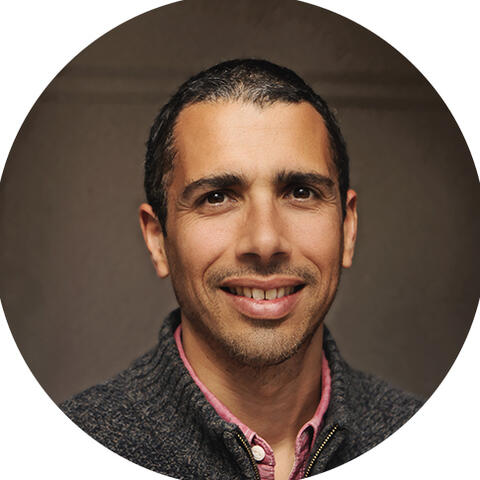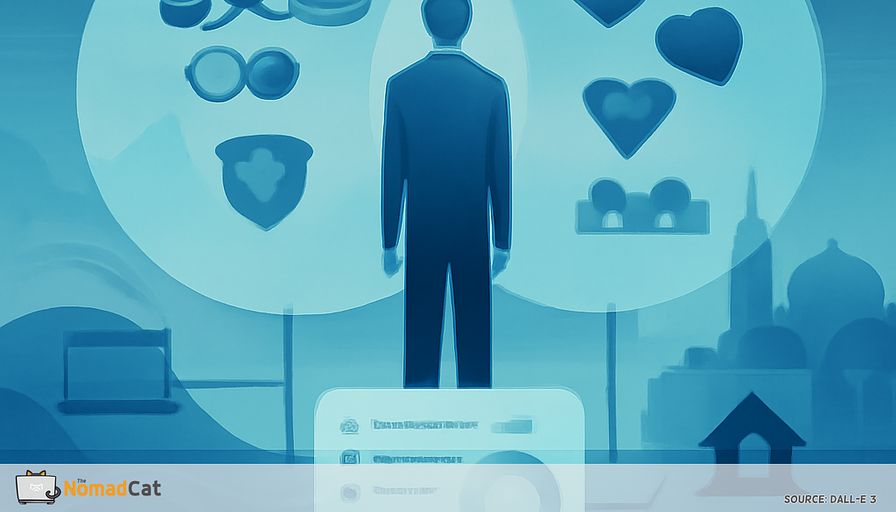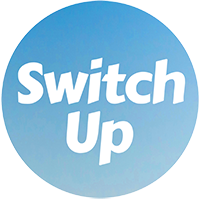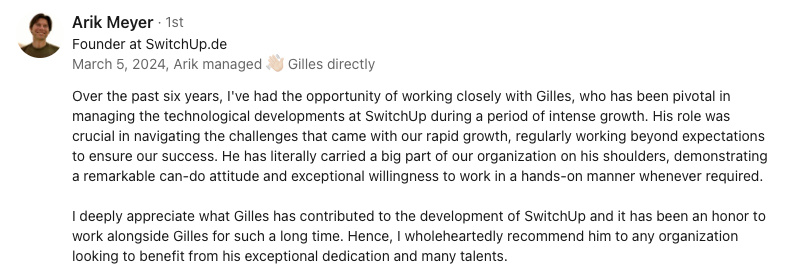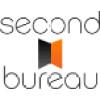Abstract:
The article challenges conventional financial advice for tech professionals, arguing that standard savings rules and runway calculators often fail to account for the unique needs of those who value flexibility, minimalism, or remote work. It introduces a personalized approach to career transition readiness, emphasizing that “enough” is subjective—shaped by individual lifestyle choices, support systems, and personal non-negotiables rather than fixed financial formulas. The article presents the “dual buffer” model, which balances financial preparedness with emotional support from networks like family, friends, or mentors, and provides practical tools for self-assessment, such as customizable scorecards and checklists that weigh factors like savings, debt, health insurance, and support network strength according to personal priorities. It advocates for regular reflection, scenario-based stress-testing (both financial and emotional), and routines like journaling or mindful check-ins to keep plans current and decisions grounded. Unique elements include real-life examples—such as Patrick McKenzie, Jesse Hertzberg, and Rand Fishkin, who each tailored their career exits to their own blend of financial and emotional readiness—and the integration of minimalist and FIRE community insights, highlighting the broad range of comfort zones around what constitutes “enough.” Ultimately, the article guides readers to define their own thresholds for risk and security, using flexible frameworks that combine practical planning with self-awareness, so career changes feel confident, intentional, and aligned with personal values rather than generic benchmarks.
Ever feel like the usual financial advice doesn’t quite fit if you work in tech and value flexibility over just stacking up savings? Most runway calculators and savings rules assume everyone’s needs are the same, but for tech professionals living simply or working remotely, those tools can miss important details. What counts as “enough” really depends on your choices, your support, and what you care about most.
I’ve had to rethink “enough” more than once—moving from Beijing to Berlin, then later to Lisbon, each time with a different set of priorities and a new definition of security. The spreadsheets never quite matched the reality of hopping countries or founding a science popularization company in the late 1990s, when my only buffer was a tiny savings account and a few friends willing to lend a couch.
This article offers a new way to see readiness for career changes. I’ll show you where standard advice falls short for people choosing minimalist habits, and how those habits can make transitions safer—even with less money in the bank. There’s the idea of a double buffer, where your support network matters as much as your savings. You’ll also find practical ways to check if your safety net is sturdy enough. Step by step, I’ll walk you through building a scorecard that fits your life, stress-testing your plans, and setting boundaries for your personal non-negotiables.
By the end, you’ll have simple methods and real strategies for making confident decisions. Whether you’re planning a jump into something new or just want to feel more secure, this can help you make “enough” fit your own life, not just someone else’s spreadsheet.
Why ‘enough’ is personal
Rethinking runway advice
Ever notice how financial calculators often assume everyone needs the same amount, whether you travel the world or prefer a fixed daily routine? The classic “six months of savings” wisdom feels like it’s made for everyone—when in fact, everyone’s needs are different. For tech professionals, especially those interested in minimalism or remote work, these tools can feel a bit off. Generic runway rules just don’t match up well when your lifestyle breaks the old models.
When tech careers outgrow old models
Tech isn’t just about sitting in offices anymore. Many now have multiple income streams, remote jobs, or even move to new countries on short notice. That means how much money you need each month can change a lot, sometimes being much less than old calculators would suggest. Minimalist values make this difference even stronger, with the focus more on adaptability than on just piling up cash. The idea of “work, save, retire” doesn’t really fit when your job path weaves through projects, a remote team, or hopping cities.
Minimalist habits and a shorter runway
When I moved from Berlin to Lisbon, I realized that my real runway wasn’t just about the number in my bank account. Downsizing my apartment, selling off extra gear, and setting up automatic savings (a habit I picked up as a CTO juggling unpredictable startup cash flows) made a bigger difference than any spreadsheet formula. For example, by cutting my fixed expenses by 40% and automating transfers to a separate “runway” account, I bought myself an extra three months of breathing room—without needing to double my savings. In my experience, these practical steps matter more than any generic “industry data” ever did.
Minimalist values redefine enough
Freedom and adaptabilityIf your main goal is freedom, “enough” isn’t just a bank number—it’s about adaptability and the ability to live simply. When I first landed in Berlin, I cared more about being able to pack up and move or cut expenses quickly than about hitting some magic savings target. That mindset reshaped my everyday habits, making “enough” less about a fixed number and more about flexibility and what truly matters.
Minimalist habits as a safety netI’ve found that minimalist values—like saving automatically, staying out of debt, and building flexible work setups—become a kind of built-in safety net. Before leaving my CTO role in Berlin, I set up a system where 15% of every freelance invoice went straight to a “buffer” account. That habit, plus keeping my life light enough to move cities in a week, made the idea of a big emergency fund less urgent. To find your own “enough,” it helps to reflect on your priorities and create habits that keep you resilient, even when things change unexpectedly.
Personalizing your definitionInstead of copying the same formulas, professionals with minimalist values benefit from a blended approach—using both numbers and an honest look at what feels comfortable for their lifestyle. Getting clear on your own version of “enough” can boost confidence and limit regrets, especially during big work changes. This is where the idea of a dual buffer makes sense, bringing in a plan that covers both money and emotional readiness.
The dual buffer model
Emotional support matters
Money isn’t everything when you’re planning a safe job change. In my own moves—especially the leap from Berlin to Lisbon—support from partners, friends, and even online groups mattered just as much as my bank balance. Support doesn’t only come from your closest family—it can be mentors, a peer group, or even a Slack channel you trust. Without it, even a solid bank account can feel weak when the unexpected happens.
Support can take lots of forms: friends to talk with, feeling psychologically safe, or family members who are on board. These things cushion stress and help you bounce back. A reliable support network is often what helps people recover and adapt fastest when things go sideways.
But how can you know if your support network is really up to the task? Checklists and simple tools—like the Career Transitions Inventory—can highlight emotional readiness and any areas you might want to strengthen before making a big change. These help make the emotional side of planning more visible.
Let’s break down what a strong emotional buffer looks like. A few self-assessment tools and questions can show hidden gaps and help you build a fuller picture of your safety net.
Emotional buffer checklist
To make emotional readiness more practical, a strong buffer often includes:
- Partner or family buy-in for your plans
- A couple trusted peers or mentors for honest feedback
- Access to professional or peer support networks
- Clarity on your non-negotiables
Each item lowers the risk of regret or burnout during changes. Using a checklist makes it easier to see which areas are strong and which need attention.
Before I left my CTO role in Berlin, I actually sat down with a notepad and listed out who I could call if things went sideways. I realized I had two mentors in Lisbon, a friend in Berlin who’d been through similar transitions, and my partner’s cautious but real support. That gave me the confidence to move forward, even if my financial runway wasn’t perfect.
Checklists inspired by research allow professionals to rate their support systems and spot gaps. Example questions:
- Is there someone I can call when things go wrong?
- Have I told those affected about my plans?
- Do I have a mentor or peer for honest feedback?
Answering simple questions like these shows if you’re emotionally ready for a big move.
Reflection also helps. Writing about fears or past changes can reveal emotional triggers you might not notice otherwise. By reviewing both your money and your support system, you get a clearer idea of your readiness for what’s ahead.
Building your custom safety buffer
Weighing financial and emotional factors
The numbers don’t tell the whole story. Some decision tools—like the Analytic Hierarchy Process—help you weigh what matters most: runway, debt, health coverage, and your support network. When I was preparing to leave Berlin, I realized my cash runway only mattered about 40% to me; partner support was 30%, and health and debt split the rest. That made it clear where I needed to focus.
Scoring and weighting these areas gives you a plan that’s really yours. Maybe a huge savings pile isn’t necessary if your lifestyle lets you cut expenses fast. More weight might go to your support system or health coverage. This lets you match your plan to what makes you feel secure, not just what’s usually recommended.
Blending these tools with well-being ratings and focusing on what brings mental comfort helps you keep both feelings and logic in balance. I like to use a comfort scale—asking myself, “How safe do I feel about each part?”—and then combine that with the numbers. It’s a bit like making a soup: you taste as you go, adjusting the ingredients until it feels right.
A balanced scorecard brings all this together. It’s not just about tracking money or ticking boxes—it’s a tool that fits both sensible planning and personal comfort, helping decisions become clearer as life shifts.
Here’s how a simple template can make this real, by mapping out both number goals and comfort levels as you go.
Your personalized scorecard
Being ready isn’t a one-time thing—it needs checking in and updating.
A simple scorecard might include:
- Savings runway (months)
- Debt load
- Health insurance status
- Support network strength
- Partner or family readiness
- Non-negotiables clarity
For each, give a score (1–5) and a weight that matches your own priorities. Here’s an example template:
Category Score (1–5) Weight (%) Weighted Score Savings runway 4 30 1.2 Debt load 3 15 0.45 Health insurance 5 10 0.5 Support network 4 20 0.8 Partner/family readiness 2 15 0.3 Non-negotiables clarity 5 10 0.5 Total 100 3.75This makes it fast to see which areas are strong and where more attention is needed. Updating the scores as things change helps keep your plan aligned with what’s real right now.
Scorecards, they are best when checked regularly. Life, jobs, and priorities can change quickly, so rechecking every few months keeps your sense of readiness up to date.
This routine not only keeps your plan current but also shows you where you can flex and where your boundaries are solid. For example, a stronger support network might be enough if your savings aren’t massive. But if family support drops, maybe it’s time to wait before making a move.
With a scorecard, you can see trade-offs and choose more clearly. Maybe you have a strong emotional buffer and just a moderate financial runway—if that feels safe, you can proceed. If your support network isn’t strong enough yet, holding back to reinforce it might feel right. This sort of personal review helps you avoid regret and tailor your next steps.
But how do you check if your buffer will last when times get tough? Stress-testing the scorecard—by imagining hard scenarios or using reflection—can expose weaknesses before they become real problems.
Stress-testing your safety buffer
Realistic scenarios
Scenario analysis is a trusted method in business and personal finance because it makes planning real. When I was in Lisbon, I once had a client delay payment for two months—right as the weather decided to turn from sunny to “why did I ever leave Berlin?” That’s when my buffer got a real-world test. I had to cut back on eating out, dip into my “runway” account, and lean on a friend for a short-term project. That experience showed me exactly where my plan was strong and where it needed patching.
Good stress-testing checks your cash flow, your quickest assets, and which backup plans work for each possible setback. Try mapping out what you’d do if your main income vanished for two months. What could you cut? Which assets could you tap? How fast could you bounce back? This kind of exercise turns vague worries into clear action steps.
Emotional stress-testing matters too. Doing “fire drills” for tough talks with a partner or journaling about how you’d react to your worst scenario can bring hidden worries out into the open. Practice explaining a sudden career pivot to your family before it happens, for example. These exercises aren’t about expecting the worst, just being confident you’re ready for it.
Writing about your biggest fears, or acting out a tough conversation, can uncover vulnerabilities before they become major problems. By mixing scenario practice with emotional drills, you’re not just ready for financial surprises—you know you can handle emotional ones, too.
Reflection prompts for emotional triggers
Reflection prompts are handy for seeing weaknesses and getting clear about limits before major changes. When I moved from Berlin to Lisbon, I remember lying awake wondering, “What if I can’t find work for three months? Who would I call first?” That question led me to reach out to an old mentor, who ended up connecting me to my first Lisbon client.
Some prompts to try:
- What outcome am I most afraid of?
- When did I feel unprepared in the past, and how did I recover?
- Who would I reach out to first if things got rough?
Taking time with these gently, without too much self-judgment, can reveal blind spots or areas that need shoring up.
Financial therapy research points to the value in exploring past money experiences or past transitions. Often, worries about risk or change come from old lessons, not just today’s reality. Spotting those patterns can help you smooth out the roughest parts before they cause trouble. By mixing reflection and scenario analysis, you make decisions that fit both your needs and your comfort zone.
With these tools, you can see more clearly when you’re truly ready and what kind of buffer keeps you feeling secure. Next is figuring out which compromises you’re good with, and which needs must always be met.
Trade-offs: where to flex and where to stand firm
Defining deal-breakers
Thoughts from psychology and career planning show that everyone has certain needs—like health, steady income, or family stability—that count as non-negotiables. If you need health insurance, that’s probably not something you can skip. If your home life has to stay steady for your kids, that’s another clear need. Other things, like where you live or money for hobbies, can usually be adjusted more easily. Knowing your hard lines makes it easier to make choices without too much second-guessing.
Feedback from people you trust and time spent reflecting can help make your true boundaries clearer. If a certain worry keeps coming up—like the risk of losing a stable paycheck—it might mean that area is truly non-negotiable. Sorting true needs from just preferences makes for smoother planning and less stress.
Getting clear on needs versus wants is key for trade-offs, making decision-making simpler and more direct. Looking at actual examples helps show how unique these boundaries can be.
Micro-case studies: different versions of ‘enough’
Real life shows that every tech career transition looks different. Patrick McKenzie, for example, waited for a solid financial runway and family support before leaving his job. Jesse Hertzberg built up his savings for a break, balancing travel with keeping career opportunities open. Rand Fishkin made his move only after having both the savings and emotional plan he needed, then started a business that fit his personal values better.
For me, leaving my CTO role in Berlin was a balancing act. I had six months of runway, but what really tipped the scales was a conversation with my partner and a mentor in Lisbon. We mapped out my non-negotiables—health insurance, a minimum monthly income, and the ability to visit family in France twice a year. I used a simple spreadsheet (and a lot of coffee) to score each area. When my “support network” and “non-negotiables clarity” both hit 4 out of 5, I knew it was time to go. I still remember the nervous excitement of booking that one-way ticket, wondering if I’d made a mistake, but trusting the process I’d built.
Minimalist and FIRE communities highlight a wide range of comfort zones. Some tech professionals are fine with a lean buffer, feeling sure they can manage expenses and changes. Others, even when living simply, like having a big safety net just in case. One person might take action with three months of savings and few expenses; another won’t move until they’ve built a whole year’s cushion.
What matters most isn’t a perfect number, but being honest about which trade-offs work for you. Once you’re clear, planning and timing a move becomes much more straightforward.
Timing your exit with confidence
Making your scorecard actionable
Setting a target exit date makes more sense when you use a personal scorecard and set clear goals. Rather than just trusting your feelings, you line up your decision with real financial and emotional milestones—a set savings runway, strong support, and clear non-negotiables, for example. This shifts the choice from a wild guess to a series of specific triggers. Still, the plan will probably need adjusting as things change.
Regular check-ins—every month or quarter—keep the plan practical. Checking your scorecard regularly helps you avoid both endless planning and rushed decisions. It also helps you adjust for new changes at work or in life.
Digital tools make this even easier. Spreadsheets or simple apps can turn your plan into a living chart. You can update scores and weights as your situation shifts. This way, tracking your progress feels natural, not a chore. Routines also help keep decisions thoughtful and grounded.
Healthy routines for better decisions
Simple methods—like pros and cons lists or balance sheets—cut through confusion on big decisions. They help you weigh your options without getting overwhelmed.
Reflection and check-ins with others matter too. Journaling, planned review times, or even regular chats with a mentor can lead to honest self-checks and help you make quick course corrections. These routines let you see both the hard facts and your feelings before you make a call.
Mindfulness practices, like taking a few minutes to pause before making big moves, help you avoid both endless waiting and hasty exits. With these habits, starting a new chapter feels less scary and more aligned with what matters to you. And if the Lisbon rain starts up again, well, at least you’ll have a plan to review while you wait for the sun.
Figuring out “enough” is more than just counting money. It’s understanding your values, habits, and the strength of your support. By combining minimalist ideas with practical tools like a personal scorecard and a dual buffer, you can plan career moves that really fit you, not just a standard template. Checking on your readiness, reflecting honestly, and practicing your plan can help you feel less anxious about big transitions. Flexibility, emotional readiness, and knowing your non-negotiables all matter as much as the money part. There’s no single path, and your version of readiness will be personal. Use these ideas to figure out your next step, in a way that feels right for your life.
